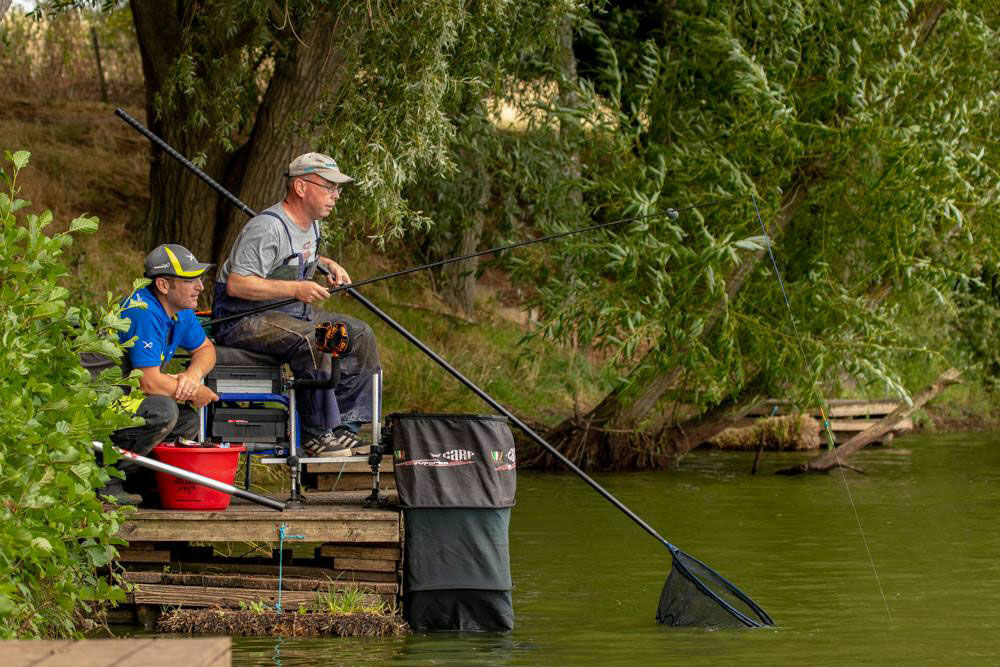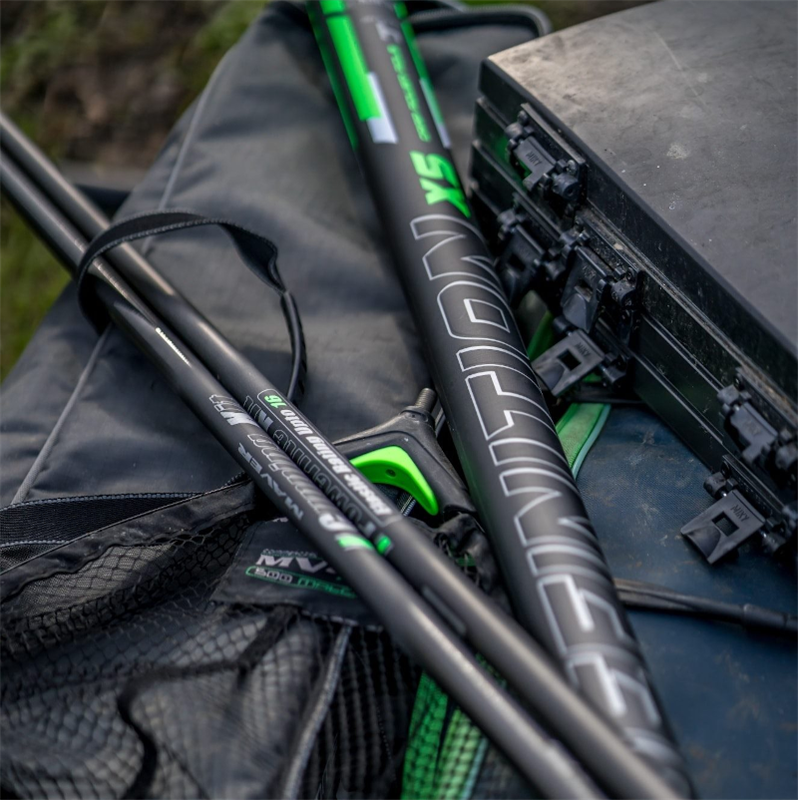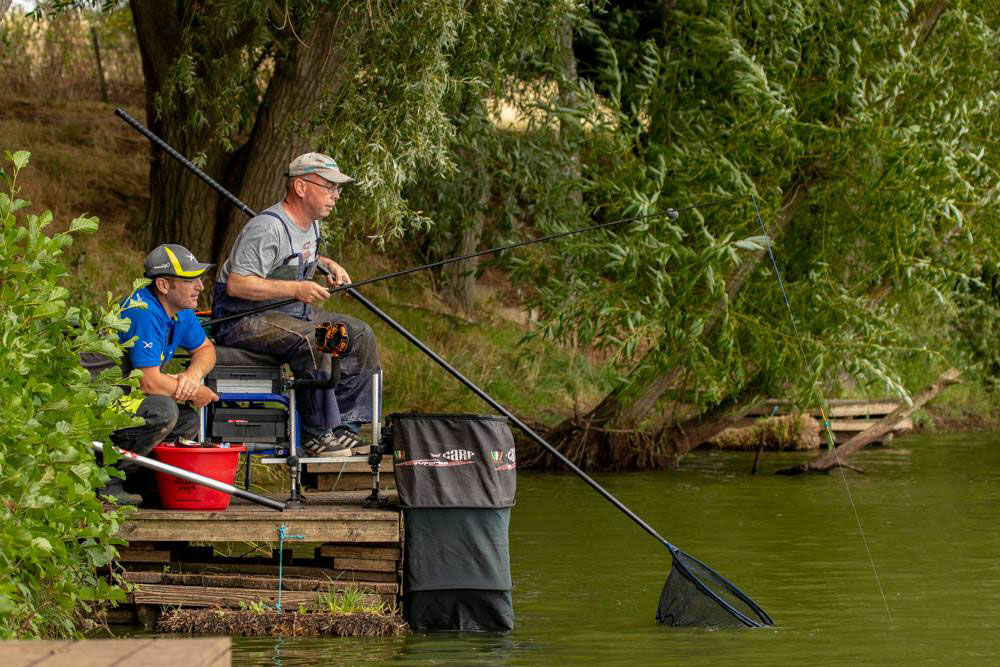Pole Fishing Essentials: A Practical Guide for Anglers
- By Andy Grenfell
- |
- 26 August 2025

Pole fishing is a precise angling method using a long pole instead of a rod and reel. Fishing poles are available up to 16m in length and can be constructed in sections that taper to create longer lengths. This guide covers the basics, from choosing a pole to setting it up and using key techniques. By the end, you’ll understand why many anglers prefer pole fishing.
Table of Contents
- KEY TAKEAWAYS
- UNDERSTANDING POLE FISHING
- CHOOSING YOUR FIRST FISHING POLE
- SETTING UP YOUR POLE
- TOP KITS EXPLAINED
- SELECTING POLE ELASTICS
- THE ROLE OF POLE FLOATS
- PLUMBING THE DEPTH
- BALANCED TACKLE: WHY IT MATTERS
- ESSENTIAL POLE ACCESSORIES
- EFFECTIVE FEEDING TECHNIQUES
- COPING WITH WINDY CONDITIONS
- HOOKBAITS & RIGGING
- MAINTAINING YOUR POLE
- ADVANCED POLE FISHING TACTICS
- SUMMARY
Key Takeaways
- Pole fishing has evolved significantly over time, with modern poles allowing for greater length, precision in bait placement, and enhanced sensitivity, making it appealing to both novice and experienced anglers.
- Proper setup, including using pole rollers and balanced tackle, is essential for stability and effectiveness in pole fishing, while selecting the right top kits and elastics is crucial for targeting specific fish species. Most modern poles are sold as packages with extra top kits, allowing for multiple rig setups for different scenarios.
- Advanced techniques, such as effective feeding strategies and mastering bait presentations, are important for attracting fish and improving catch rates, highlighting the need for ongoing skill development among anglers.
Understanding Pole Fishing
Pole fishing can be traced back to the origins of angling, with modern techniques recognised from around 150 years ago in London’s canals. The evolution from bamboo to advanced materials like fibreglass and carbon fibre has allowed poles to reach impressive lengths, exceeding 52 feet. Many modern poles are constructed in tapered sections, allowing for greater lengths and easier storage. This historical progression highlights the enduring appeal and continuous innovation within the practice.
The structure of a long pole consists of multiple pole sections and a pole section that connects via joints, enabling anglers to adjust the fishing distance with precision. Unlike traditional methods that use free-running lines or reels, pole fishing relies on a float fixed directly to the pole tip, enhancing sensitivity and accuracy. This setup allows anglers to detect even the slightest bites, making it a preferred choice for many.
One of the key advantages of pole fishing is the ability to place bait with pinpoint accuracy. This method offers:
- Minimal casting, allowing for precise bait placement and quick adjustments to rig positioning.
- Enhanced sensitivity through the use of lighter floats, improving the chances of detecting bites.
- A more responsive and engaging fishing experience—consider further enhancing your setup by exploring our coarse fishing tackle and gear product range.
With modern poles, anglers can manage their techniques with exceptional control. Whether you’re fishing in a canal, lake, or river, the versatility and effectiveness of pole fishing make it a popular choice for both novice and experienced anglers. Mastering pole rigs, margin poles, and various accessories can lead to a successful and enjoyable angling adventure.
Choosing Your First Fishing Pole
Selecting your first fishing pole is an exciting step in your angling journey. Budget plays a crucial role, as a good starter margin pole typically costs between £50 and £100. Investing in a quality pole ensures durability and a better fishing experience, making it important to balance cost and quality.
Consider the type of fish you aim to catch and the fishing locations you frequent: Poles are designed with multiple 'top kits' which allow for different rigs to be used depending on the fishing scenario.
- For coarse fishing, stronger and longer poles are ideal.
- For silver fish and smaller fish, lighter poles are suitable.
- Whether you’re aiming for the far bank or fishing closer with a short pole, understanding the different options will help you make an informed decision and enhance your angling success.
Setting Up Your Pole
Properly setting up your fishing pole is essential for stability and success. Begin by aligning and securing each section of the pole correctly. Ensure that the sections are spaced properly to allow for smooth extension and retraction during use. This meticulous assembly process helps prevent damage and maintains the pole’s functionality.
Using a pole roller is an effective way to keep your pole elevated, reducing friction and wear. Pole rollers significantly reduce the risk of damage while fishing, enhancing your overall experience. Combining proper assembly techniques with pole rollers protects your equipment and enhances your chances of a successful catch.
Top Kits Explained
Top kits play a crucial role in enhancing control and efficiency during pole fishing. Standard top kits are suitable for traditional silver fishing with light to medium elastics, making them the most commonly used option. Modern poles generally have multiple 'top kits', which are the end sections where the float rig is connected, enhancing versatility in pole fishing. These kits are designed to match the quality of the pole, ensuring optimal performance.
For larger fish, puller kits provide increased control during the landing process. Many anglers in the UK find that compact puller kits are especially effective in shallow waters, allowing anglers to manage large fish and small fish quickly and efficiently with a reel.
Selecting a fishing pole based on the type of fish and conditions ensures the best match for your needs.
Selecting Pole Elastics
Pole elastics are categorised into three types, each suited for different fishing styles and target species:
- Solid elastics.
- Hollow elastic, which provides a progressive increase in power as they stretch, offering greater shock absorption and control when landing larger fish.
- Hybrid elastics. Hollow elastics rated between #4 and #12 are suitable for larger silvers and F1s.
Choosing the right strength of stronger elastic is crucial and depends on several factors:
- The expected size of the catch.
- The fishing venue.
- Environmental conditions.
- Performance elastic rating from different manufacturers and suggested elastic ratings. Considering these factors helps avoid mismatches and enhances fishing success.
The Role of Pole Floats
Pole floats are vital for enhancing visibility in various lighting conditions, making them easier to spot when fishing. The shape of the pole floats affects their buoyancy and sensitivity, impacting the angler’s ability to detect bites. Choosing the right float can significantly improve the effectiveness of your fishing setup.
Floats with a pronounced top design provide better buoyancy, especially in open water. Sensitivity can be increased by opting for finer bristles, which can detect minor details but may be less visible while you swim.
Using the right pole float tailored to your fishing conditions will enhance your overall success and enjoyment.
Plumbing the Depth
Plumbing the depths is crucial for success in pole fishing. Start by passing the hook through the eye on your plummet and ensure that your pole is extended to the full length needed to reach the desired spot. This technique allows you to measure the water depth accurately, ensuring that your bait is positioned correctly for optimal results.
Balanced Tackle: Why It Matters
Balanced tackle in pole fishing is essential for minimising risk to your equipment and maximising your chances of a catch. Ensuring that your hook length breaks first, followed by the mainline, helps protect the pole from damage. This balance keeps the fish’s attention while reducing the risk of losing tackle.
To achieve a balanced tackle:
- Hook length should be one diameter down from the mainline.
- Select hooks that correspond with the line diameter to maintain balance.
- Use a line with a maximum recommended breaking strain of 6lb for safety and effectiveness.
Essential Pole Accessories
Pole accessories are indispensable for enhancing your fishing experience. A pole sock is essential for holding the end of the pole safely when not in use. Pole rollers provide stability and prevent the pole from blowing away, making them crucial for efficient fishing. Choosing a suitable seat box for pole fishing is essential for maintaining comfort and preventing back injuries during extended sessions.
A spray bar, also known as a front pole rest, holds the rod in a stable position while fishing, reducing fatigue and improving accuracy. Pole roosts help organise and store multiple sections of the pole easily.
Additionally, a good seat box with a footplate, fully adjustable legs, and comfort features is vital for preventing long-term back injuries. A good seat box should allow the angler to sit with their knees at a near 90° angle with feet flat on the footplate. Investing in these accessories will enhance your overall fishing experience and protect your equipment.
Effective Feeding Techniques
Effective feeding techniques are crucial for attracting fish and maintaining their interest. Pole fishing allows for precise bait presentation by centring bait on a pinhead among free offerings. Feeding methods in pole fishing can include cupping in, hand feeding, and using a catapult. Using a pole pot achieves significant accuracy and sensitivity to bites, enhancing your chances of success.
Feeding and bait strategies for fishing include:
- Feeding less but more frequently during cold weather.
- Maintaining a balance of feeding little and often in shallow fishing to keep fish competing for bait at the surface.
- Simplifying bait choices to just a few effective types, such as pre-drilled tiger nuts and various wafters, to reduce confusion and increase focus on fishing.
Mastering these techniques helps keep fish engaged and improves your catch rates.
Coping with Windy Conditions
Windy conditions can significantly impact pole fishing, making it essential to adapt techniques for stability and control. Fishing closer to the bank with a shorter pole length improves control and stability. Increasing the float size can enhance stability, though it might compromise the bait’s presentation.
Adjusting bait presentation techniques and using lighter elastic can also reduce erratic pole movements and other methods, helping you maintain effectiveness even in challenging conditions.
Hookbaits & Rigging
Choosing the right hook baits and mastering rigging techniques are vital for successful pole fishing. Key points include:
- Pellets are highly effective in shallow fishing, known for their ability to attract fish with minimal quantities.
- Using a combination of different pellet sizes can enhance your fishing success.
- Matching pellet sizes with the appropriate hookbait is important for better results.
There are several examples of hook baits that can be attached directly to the hook. These include:
- Maggots.
- Casters.
- Expander pellets.
- Corn.
- Bread.
Properly tying the hook to the line is essential to prevent it from slipping during use.
The Jigger rig allows for flexible depth adjustments and is effective for catching fish by jiggling the bait. By mastering these bait and carp rig techniques, you’ll improve your chances of a successful catch.
Maintaining Your Pole
Maintaining your fishing pole is crucial for ensuring its longevity and performance. Cleanliness is important to prevent grit accumulation, which can damage pole joints. Check the line for any twists or tangles before fishing to avoid complications.
Essential practices for storing your fishing pole include:
- Using top kit cases for efficient storage.
- Using base caps to protect the lower sections from damage.
- Storing your fishing pole in a climate-controlled environment to avoid damage from extreme temperatures.
Following these maintenance tips keeps your pole in top condition for many successful pole care fishing trips.
Advanced Pole Fishing Tactics
For those looking to elevate their pole fishing game, advanced tactics can make a significant difference. Fishing in tight spots like weed beds requires specialised pole rigs for effective access. Using a pole pot allows for consistent bait delivery right where the rig is placed, enhancing catch rates.
Precision baiting techniques can significantly increase the likelihood of attracting bigger fish. Carp tend to inhabit margins, making targeting these areas crucial for successful fishing. Margin fishing is a popular tactic for targeting large fish close to the bank in commercial fisheries. By mastering these advanced tactics, you’ll be able to catch big carp and take your angling skills to the next level.
Summary
In summary, pole fishing offers a unique and rewarding angling experience. By understanding the essentials, from choosing the right pole and accessories to mastering feeding techniques and advanced tactics, you can enhance your fishing success. Embrace the precision and control that pole fishing provides, and let your passion for angling guide you to new heights. Happy fishing!








